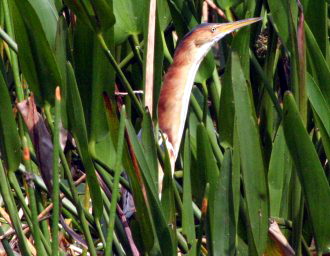Least Bittern (Ixobrychus exilis) - Wiki Least Bittern
From Wikipedia, the free encyclopedia
[Photo] Least Bittern (Ixobrychus exilis) taken in Lake Hollingsworth, Lakeland, Florida. Photo by Albuttlee. License: public domain
The Least Bittern (Ixobrychus exilis) is a small wading bird, the smallest heron found in North America.
This bird's underparts and throat are white with light brown streaks. Their face and the sides of the neck are light brown; they have yellow eyes and a yellow bill. The adult male is glossy greenish black on the back and crown; the adult female is glossy brown on these parts. They show light brown parts on the wings in flight.
These birds nest in large marshes with dense vegetation from southern Canada to northern Argentina. The nest is a well-concealed platform built from cattails and other marsh vegetation. The female lays 4 or 5 eggs. Both parents feed the young by regurgitating food. A second brood is often produced in a season.
These birds migrate from the northern parts of their range in winter for the southernmost coasts of the United States and areas further south, travelling at night.
They mainly eat fish and insects, which they capture with quick jabs of their bill while climbing through marsh plants.
The numbers of these birds have declined in some areas due to loss of habitat. They are still fairly common, but more often heard than seen. They prefer to escape on foot and hide than to take flight. These birds make cooing and clucking sounds, usually in early morning or near dusk.
Protected status
The Least Bittern (Ixobrychus exilis) is protected under the Migratory Bird Treaty Act of 1918.
http://en.wikipedia.org/wiki/Least_Bittern
| The text in this page is based on the copyrighted Wikipedia article shown in above URL. It is used under the GNU Free Documentation License. You may redistribute it, verbatim or modified, providing that you comply with the terms of the GFDL. |
